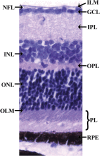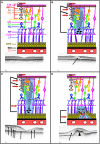Origins and consequences of hyperosmolar stress in retinal pigmented epithelial cells
- PMID: 24910616
- PMCID: PMC4038854
- DOI: 10.3389/fphys.2014.00199
Origins and consequences of hyperosmolar stress in retinal pigmented epithelial cells
Abstract
The retinal pigmented epithelium (RPE) is composed of retinal pigmented epithelial cells joined by tight junctions and represents the outer blood-retinal barrier (BRB). The inner BRB is made of endothelial cells joined by tight junctions and glial extensions surrounding all the retinal blood vessels. One of the functions of the RPE is to maintain an osmotic transepithelial gradient created by ionic pumps and channels, avoiding paracellular flux. Under such physiological conditions, transcellular water movement follows the osmotic gradient and flows normally from the retina to the choroid through the RPE. Several diseases, such as diabetic retinopathy, are characterized by the BRB breakdown leading to leakage of solutes, proteins, and fluid from the retina and the choroid. The prevailing hypothesis explaining macular edema formation during diabetic retinopathy incriminates the inner BRB breakdown resulting in increased osmotic pressure leading in turn to massive water accumulation that can affect vision. Under these conditions, it has been hypothesized that RPE is likely to be exposed to hyperosmolar stress at its apical side. This review summarizes the origins and consequences of osmotic stress in the RPE. Ongoing and further research advances will clarify the mechanisms, at the molecular level, involved in the response of the RPE to osmotic stress and delineate potential novel therapeutic targets and tools.
Keywords: age-related macular degeneration; blood-retinal barrier; diabetes; edema; hyperosmolar stress; retinal pigmented epithelium; uveitis.
Figures




References
Publication types
LinkOut - more resources
Full Text Sources
Other Literature Sources

